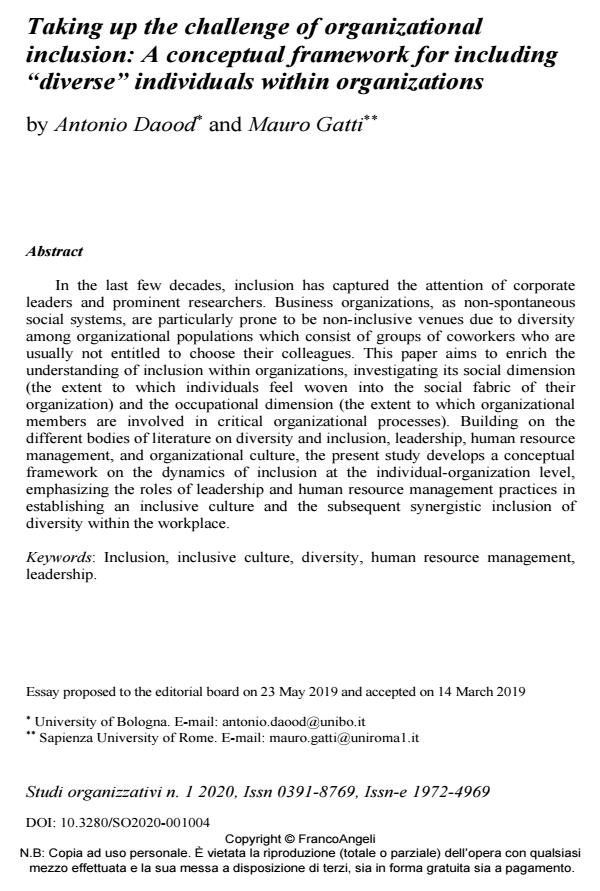Taking up the challenge of organizational inclusion: A conceptual framework for including "diverse" individuals within organizations
Titolo Rivista STUDI ORGANIZZATIVI
Autori/Curatori Antonio Daood, Mauro Gatti
Anno di pubblicazione 2020 Fascicolo 2020/1
Lingua Inglese Numero pagine 25 P. 93-117 Dimensione file 299 KB
DOI 10.3280/SO2020-001004
Il DOI è il codice a barre della proprietà intellettuale: per saperne di più
clicca qui
Qui sotto puoi vedere in anteprima la prima pagina di questo articolo.
Se questo articolo ti interessa, lo puoi acquistare (e scaricare in formato pdf) seguendo le facili indicazioni per acquistare il download credit. Acquista Download Credits per scaricare questo Articolo in formato PDF

FrancoAngeli è membro della Publishers International Linking Association, Inc (PILA)associazione indipendente e non profit per facilitare (attraverso i servizi tecnologici implementati da CrossRef.org) l’accesso degli studiosi ai contenuti digitali nelle pubblicazioni professionali e scientifiche
In the last few decades, inclusion has captured the attention of corporate leaders and prominent researchers. Business organizations, as non-spontaneous social systems, are particularly prone to be non-inclusive venues due to diversity among organizational populations which consist of groups of coworkers who are usually not entitled to choose their colleagues. This paper aims to enrich the understanding of inclusion within organizations, investigating its social dimension (the extent to which individuals feel woven into the social fabric of their organization) and the occupational dimension (the extent to which organizational members are involved in critical organizational processes). Building on the different bodies of literature on diversity and inclusion, leadership, human resource management, and organizational culture, the present study develops a conceptual framework on the dynamics of inclusion at the individual-organization level, emphasizing the roles of leadership and human resource management practices in establishing an inclusive culture and the subsequent synergistic inclusion of diversity within the workplace.
Negli ultimi decenni, il concetto di inclusione ha colto l’attenzione di corporate leader e studiosi di rilievo. Le imprese, in quanto sistemi sociali di natura non spontanea, sono particolarmente inclini a configurarsi come luoghi non inclusivi a causa dell’alto tasso di diversità della popolazione aziendale, composta da persone alle quali solitamente non è consentita la scelta dei propri collaboratori e delle proprie collaboratrici. Questo articolo si focalizza sull’inclusione di individui “diversi” all’interno delle organizzazioni, distinguendo la sua dimensione sociale, ovvero la misura in cui gli individui si sentono parte del tessuto sociale dell’organizzazione, dalla sua dimensione occupazionale, quindi la misura in cui i membri dell’organizzazione sono coinvolti in processi organizzativi critici. Attingendo dalla fiorente letteratura su diversità e inclusione, leadership, HRM, e cultura organizzativa, l’articolo analizza le dinamiche dell'inclusione a livello individuo-organizzazione, sottolineando come attraverso le pratiche di leadership e di HRM si possa creare una cultura volta all’inclusione sinergica della diversità all’interno dell’impresa.
Parole chiave:Inclusione, cultura inclusiva, diversità, HRM, leadership.
Antonio Daood, Mauro Gatti, Taking up the challenge of organizational inclusion: A conceptual framework for including "diverse" individuals within organizations in "STUDI ORGANIZZATIVI " 1/2020, pp 93-117, DOI: 10.3280/SO2020-001004